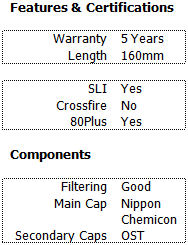PC Power & Cooling Silencer 500W
by Christoph Katzer on June 9, 2008 2:00 AM EST- Posted in
- Cases/Cooling/PSUs
Conclusion
The Silencer 500 leaves a great impression when it comes to external appearance and packaging, but the story changes once we begin testing with our Chroma. The performance isn't bad - in fact, it's quite good - but somehow the Silencer 500W does not have anything to do with silence when it comes to reasonable loads. The build quality is very good as always, though it seems the secondary capacitors could have been placed better and OST might have not have been the best choice. Our real complaint lies with the fan, however.
 |
From the performance side of the equation, the power supply does well with minor flaws in output stability. The efficiency is also good, reaching up to 86% with 230VAC and up to 84% with 120VAC. The optimal load for this power supply is 100 to 200W of power - about what you would need for a decent system with a 9800 GTX paired with an Intel E8500 or Q9300. For that sort of system, acoustic noise levels should remain acceptable as well.
At loads above 200W, however, acoustic noise becomes a real concern. There is simply no need to cool a 500W power supply with a 3200 RPM fan and a resulting 35dB(A). We have tested many midrange power supplies; frankly, there aren't any that reach similar noise levels. PCP&C should definitely give a second thought to noise; with small adjustments to the fan controls, we see a chance for this unit to compete with other silent units.
In terms of pricing, we have the next surprise, as the Silencer 500 will be a bargain (relatively speaking). PCP&C is known for being more expensive than competing models, but this time they're competitive with similar quality 500W offerings. The price in the US is $90, and we're told it will be an incredible 60 EUR over in Europe. Most other 500W units are at least 15-25 EUR more. Antec Earthwatts, Corsair, Seasonic, and Silverstone all have similar US prices, and they also run noticeably quieter. However, for 60 EUR there are almost certainly users who will be willing to overlook the minor flaws in voltage regulation; if you only use 250W of load (which will be easy unless you start overclocking components), you can also keep noise levels in check. The decision is as always yours, and pricing and availability will very likely play a deciding role.










22 Comments
View All Comments
xeizo - Monday, June 9, 2008 - link
I´m also positive to the importance of reporting ripple figures, the standard is max.50mV ripple but lately there is a lot of psus sold happily stating 150mV ripple in their specs even though it´s out of the standard.If such companies voluntarily reports 150mV one can only guess how high the real figures are. Or how many more companies out there are a little bit smarter and state 50mV ripple even though the real figures are mabe ~200mV.
High ripple can damage many parts in the computer, lowers performance and rises temperature. So, yes, it's pretty important and should be mentioned in all psu reviews. Not mentioning it is no guarantee that the performance is really great.
HOOfan 1 - Monday, June 9, 2008 - link
50mV is the max specification on the 3.3V and 5V rails. The max spec on the 12V rails is 120mV.